


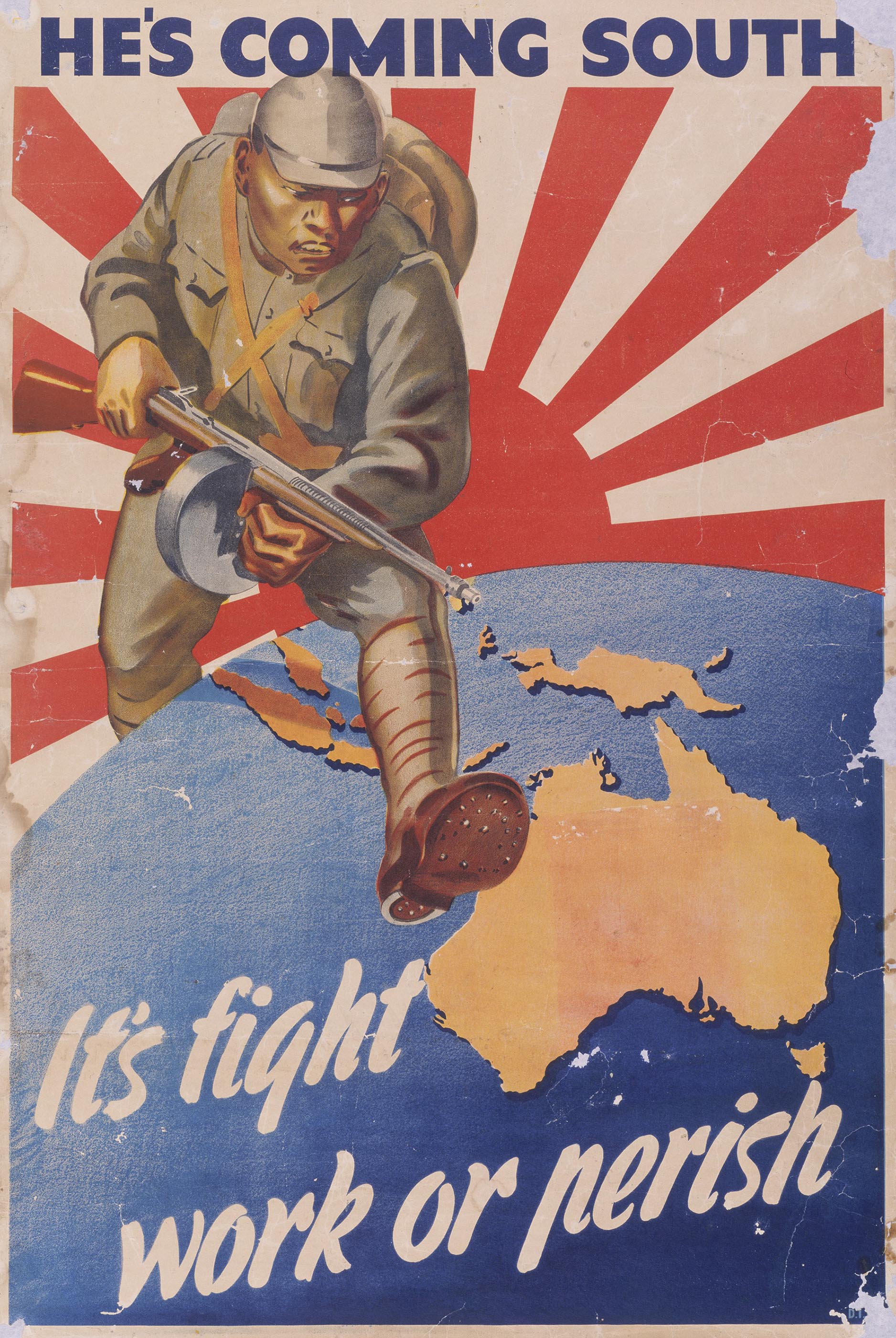 Source: National Museum of Australia
Source: National Museum of Australia
World War II was a war of propaganda, with all sides using propaganda to demonise their enemies, justify their actions, hide their war crimes, raise morale, encourage men to enlist and get support from the homefront. Read through the resources below to learn more about propaganda in World War II.
This website looks at propaganda in Germany, Britain and the United States during World War II.
The Nazis effectively used propaganda to win the support of millions of Germans in a democracy and, later in a dictatorship, to facilitate persecution, war, and ultimately genocide. The stereotypes and images found in Nazi propaganda were not new, but were already familiar to their intended audience. Read through this article to learn more.
During World War II, the US government waged a constant battle for the hearts and minds of the public. “Rosie the Riveter” and many other wartime propaganda posters remain relevant 75 years later. Read through this article to learn more.
Read through this website to learn more about propaganda during World War II.
Throughout Australia’s military history, recruitment posters have been used to persuade men and women to join one of the wartime services. Images and stories of nurses have been successful in influencing Australian society during times of war. Read through this PDF to learn more about how propaganda influenced Australian recruitment during World War II.
As Japan conquered more territory from the 1930s, and as World War Two grew in scale following the attack on Pearl Harbor in 1941, propaganda efforts across Japanese-controlled East Asian territories became more important. Here, Maddison Nichol follows up on his article on Nazi World War Two propaganda (here), and explains the importance of race and anti-Western ideology in the promotion of Japan’s East Asian Co-Prosperity Sphere.
When thousands of Wisconsin soldiers, part of the 32nd “Red Arrow” Infantry Division, arrived in Australia in May 1942, they inadvertently created an opportunity for Japanese propagandists to attack the morale of Australian troops and attempt to sow discord and distrust among the Allied forces in the Pacific Theater. A colorful collection of Japanese propaganda leaflets brought home by Wisconsin World War II veteran Sterling Schallert reveals a surprising theme of focus in this fascinating but little known aspect to the War in the Pacific. Read through this article to learn more.
Images created in times of war reveal the tensions and fears ignited by the conflicts between nations. Read through this article to see how racism is used by countries in wartime propaganda.
Seventy-four years ago, as Darwin reeled from the largest single attack mounted on Australian soil, a wave of fear about an imminent invasion by Japanese forces swept the Top End. But away from the bombings and battlefields of World War II, another sort of battle was taking place over people's hearts, minds and morale. Read through this article to learn about Japanese propaganda during WWII.


A poster produced for the Beaufort Division of the Department of Aircraft Production during the Second World War. The poster depicts a map of Australia ringed by threatening Japanese ships and aircraft. The islands of Netherlands East Indies are occupied by a Japanese Army and there are ships sinking off the coastline. The scenes within the map of Australia are of agricultural activities and sports, images of the 'Australian' way of life.

Australian propaganda posters during the Second World War (WWII) were used to instil anti-Japanese attitudes. Using racial stereotypes and derogatory humour the posters harboured fear and caution amongst Australian society. In the centre of the poster an Australian soldier is depicted enforcing blows with his fist to the chin of a Japanese soldier. The Australian soldier has far greater strength and power next to the inferior Japanese soldier. He is depicted as strong and handsome, with a broad chest and large fists, this is juxtaposed against the Japanese soldier who is weakened by his small frame and long skinny hands. Japanese soldiers were caricatured to look weak, foolish and unintelligent by emphasising stereotypes of glasses and buck teeth. These features were commonly used in Australian propaganda posters during WWII.

A Second World War poster depicting six women, representing the WRAN, AWAS, WAAAF, AWLA, AAMWS, and a munitions worker. The poster is designed to encourage women to join the services or become involved in industry to help in the war effort.
This work is a good example of the recruitment posters aimed at women during the Second World War. It draws on elements of popular visual culture to counter the perception of only a few years before that it was inappropriate for women to enlist in the military services or to work in heavy industry and agriculture. Using bright and vibrant colours, the poster employs imagery typical of pre war and contemporary advertising in its line up of attractive, radiant women of indeterminate age and social standing. The six women depicted include members of the three services, army and civilian nurses and, right at the front, a generic factory worker or land army girl. The imagery and the wide range of occupations make the poster all-encompassing, implying that there is a job for every Australian women and that she must take it up. The airbrushed attractiveness of the women also suggests that women who take up these new forms of employment retain their femininity, a major concern for men, and a reassurance for the women that their new and unfamiliar roles were legitimate.

Propaganda poster referring to the threat of Japanese invasion. A Japanese soldier is striding across the globe towards Australia with the Imperial Japanese flag behind him. He is armed with a submachine gun and is about to stomp on Australia. This work highlights the psychological impact the Japanese advance had upon the Australian population, and the poster was considered so alarmist that it was not released in Queensland or Melbourne. During the Second Wold War it was assumed that the Japanese would continue their southward advance and invade and conquer Australia. It is now understood that although the Japanese authorities did briefly consider invading the northern part of Australia they ultimately decided to pursue a plan of isolating Australia, as they realised their military resourses would not be strong enough to hold all their conquered territory.

Poster urging people not to provide the enemy with vital information through careless talk. The concept of espionage and information falling into the wrong hands was a common feature of posters from the Second World War. This design features a map of Australia with radio waves radiating from the country to the ears of a Japanese soldier. The use of the word "weapons" draws attention to the violence of the conflict and links it with death in the mind of the viewer.
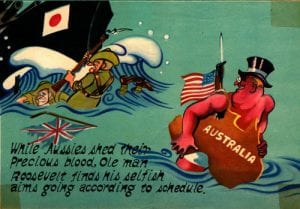
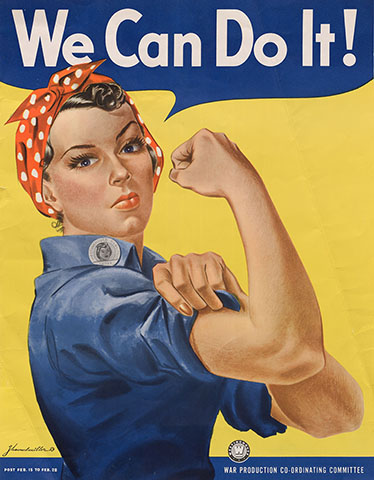
In the face of acute wartime labor shortages, women were needed in the defense industries, the civilian service, and even the Armed Forces. Despite the continuing 20th century trend of women entering the workforce, publicity campaigns were aimed at those women who had never before held jobs. Poster and film images glorified and glamorized the roles of working women and suggested that a woman's femininity need not be sacrificed. Whether fulfilling their duty in the home, factory, office, or military, women were portrayed as attractive, confident, and resolved to do their part to win the war.

During the war years, gasoline, rubber, sugar, butter, and meat were rationed. Government publicity reminded people that shortages of these materials occurred because they were going to the troops, and that civilians should take part in conservation and salvage campaigns.
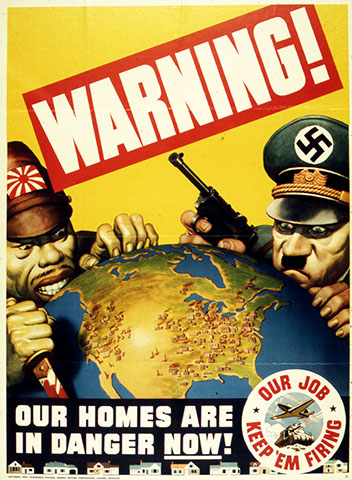
Public relations specialists advised the U.S. Government that the most effective war posters were the ones that appealed to the emotions. The posters shown here played on the public's fear of the enemy. The images depict Americans in imminent danger-their backs against the wall, living in the shadow of Axis domination.
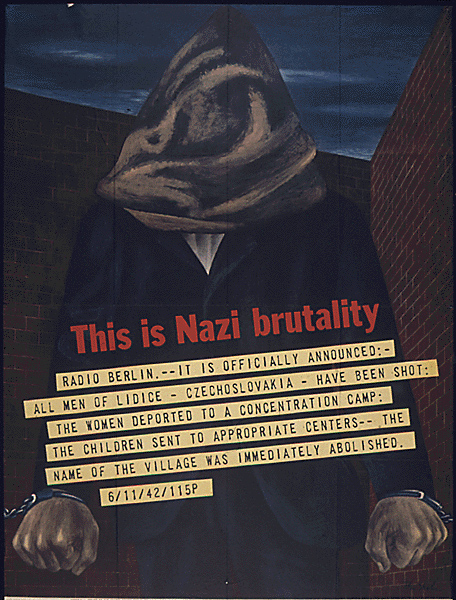
Many of the fear-inspiring posters depicted Nazi acts of atrocity. Although brutality is always part of war, the atrocities of World War II were so terrible, and of such magnitude, as to engender a new category of crime—crimes against humanity. The images here were composed to foster fear. Implicit in these posters is the idea that what happened there could happen here.
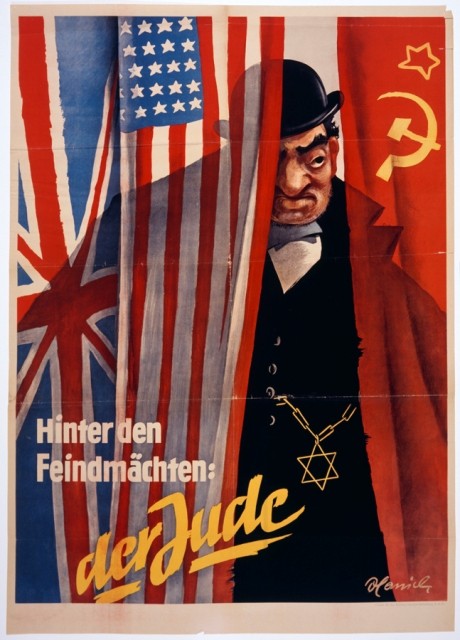
Nazi propaganda often portrayed Jews as engaged in a conspiracy to provoke war. Here, a stereotyped Jew conspires behind the scenes to control the Allied powers, represented by the British, American, and Soviet flags. The caption reads, "Behind the enemy powers: the Jew." Circa 1942.
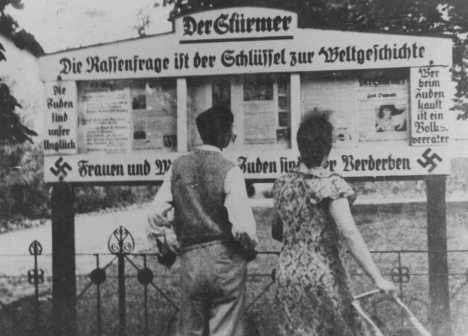
A German couple reads an outdoor display of the antisemitic newspaper Der Stürmer (The Attacker). Germany, 1935.

Poster promoting the Nazi monthly publication Neues Volk. Jews were not the only group excluded from the vision of the "national community." The Nazi regime also singled out people with intellectual and physical disabilities. In this poster, the caption reads: "This hereditarily ill person will cost our national community 60,000 Reichmarks over the course of his lifetime. Citizen, this is your money." This publication, put out by the Nazi Party's Race Office, emphasized the burden placed on society by those deemed unfit.
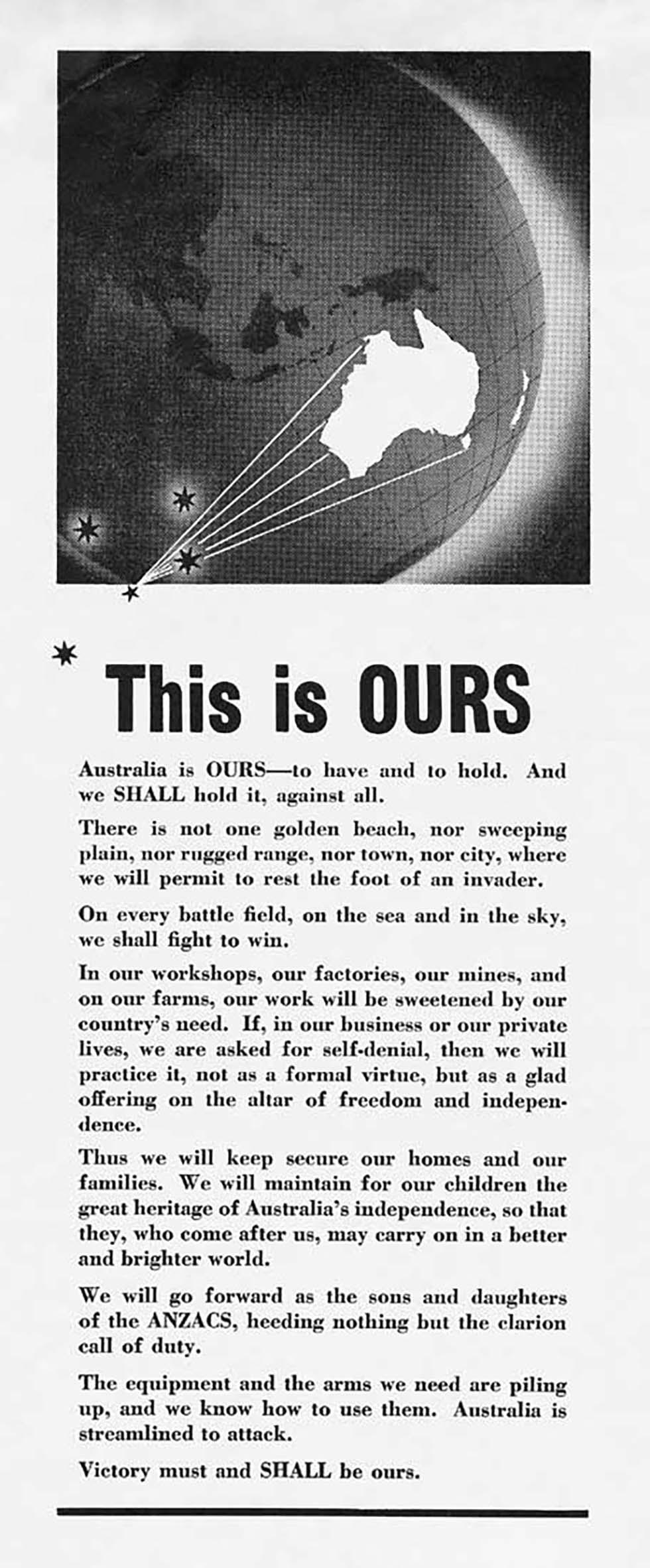
This is a black-and-white poster showing a map of the world on which Australia is highlighted and linked to the five stars of the Southern Cross. The poster is titled 'This is OURS', and its emotive text urges Australians to fight to win on the battlefield and at home.
